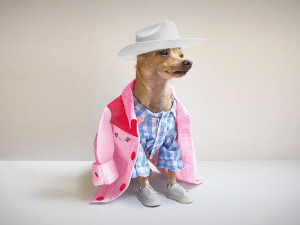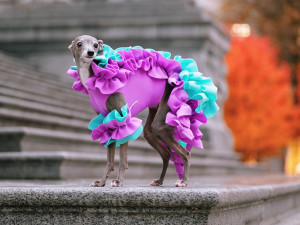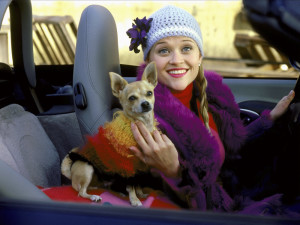Does Your Pet Have What it Takes to Be an Influencer?
Everyone thinks their pet is a star. And they’re right! Colleen Wilson, founder of animal talent agency Pets on Q, shares some trade secrets.
Everyone thinks their pet is a star. And they’re right, of course! But translating that stardom to Instagram or TikTok can be tough. And developing those posts into a full-fledged brand — with legions of devoted followers and lucrative sponsorships — is even tougher. “It’s a full time job,” says Colleen Wilson, star of the Netflix docuseries Pet Stars and founder and CEO of Pets on Qopens in new tab, an animal media and talent company based in Los Angeles, California.
“The people that make six figures, even if they have a full-time job, they still treat this like another, equally important full-time job,” Wilson adds. “They get stuff in on time. They are professional. You’d be surprised how quickly influencers can end up on a brand’s blacklist and then they never get hired again.”
Wilson’s company is the only one in the world to represent both on-set animals and influencer animals, but since the start of the pandemic, it is the influencer side of her business that has really exploded. “The pandemic pushed our work to 90% influencers,” she says. “[Brands] went from spending a lot of money on commercials, which, for a while, they couldn’t even make anymore, to working with animal influencers to market directly to animal lovers.”
As the number of animal owners increased during the pandemic, the number of people building side hustles around their pets also increased, as did the amount of money brands were willing to pay to work with them. “Everything in the industry increased!” says Wilson.
How much do you spend on your pet per year?
“Great!” you say. “Time to hop on that bandwagon!” Here’s what you should know:
1. Find your niche and stick to it.
If your thing is dressing your pet up in little outfits, do that. If it’s cool and unusual tricks, do that. If it’s just gorgeous photographs of them lying in the sun, do that. Memes? Voiceover? Whatever it is, the most important thing is that you commit.
Now, I know what you’re thinking: “But my pet has so many great qualities! Why can’t I show them all off?” Well, you can, and you might even find that you are able to draw in a bigger, more diverse following by doing so, but you won’t be doing yourself any favors in the long run. “I have some accounts [on my roster] that are bigger, but they cannot get companies [interested in them] because they’re just not keyed in enough to what their brand is,” says Wilson. “The people who make $100,000+ a year are very specific. That’s it. They stick with their niche and they kill it and every brand wants to work with them. They’ve got a waitlist.”
2. Consistency is key.
You can’t just post when you feel like it. You need a schedule and you need to stick to it. “You have to be very consistent with your posts and make sure they are of a very consistent quality,” says Wilson. Pets on Q’s roster of over 1500 influencers gets up to one billion or more impressions a week. You don’t achieve numbers like that by just posting random stuff whenever you feel like it.
3. Cats and dogs book 90% of the jobs.
Your gecko may be cute and you may be fantastically good at creating engaging, quality content with them, but you’re probably not going to make a lot of money doing so because when it comes to brand partnerships, “cats and dogs are 10 times more popular than any other pet,” says Wilson.
As for what kinds of cats and dogs are the most in demand, it really depends on the project. Pure-breed, mixed, shelter, special-needs — they all have a place in the market, according to Wilson. All except Doodles. For some reason, brands have absolutely no interest in working with Poodle mixes right now, which might seem crazy considering how popular they have become in the last few years, but there you have it.
4. It’s all about the numbers.
Your pet can be gorgeous, your content great, but at the end of the day, it all boils down to analytics. “It’s all very numbers-based,” says Wilson. “We look at a creator’s analytics and performance online [and determine the price for a brand to work with them based on that]. It really just comes down to the math and the type of content they post.”
Knowing how important followers are, you might be tempted to buy a few followers. Just to start. Don’t! Never, ever buy followers. “We can tell who has fake followers and who doesn’t,” says Wilson. “No brand is hiring anyone with fake followers these days and there has been a huge backlash against people who did it in the past.” At the same time, you need to remember that the quality of your followers is just as important as the quantity. Maybe even moreso. Especially as brands transition to working with micro-influencers, who tend to have smaller, but sometimes much more dedicated followings.
Where your followers are located also matters. “Brands are looking for influencers that speak directly to the markets they are targeting, so, for example, a company like Home Depot is probably not going to want to work with someone that has 50% of their followers in China or Bangladesh. They’d rather work with someone whose followers are spread across the US.”
5. Always remember it is important to be easy to work with and stay humble.
You don’t want to get too big for your britches and end up burning bridges by being difficult to work with. Sure, you want to advocate for yourself and your pet, but be reasonable and remember that brands have options when it comes to who they spend their money with.
“Sometimes people think they are too good for something or they push back on the brand and when you do that brands are just like ‘Okay, there are 10 other Golden Retrievers or orange Tabbies or whatever. I’ll just go with one of them instead’” says Wilson. “Don’t break your contracts or do anything that you wouldn’t do in your normal job. That’s it.”
And if you are fortunate enough to get to the level where you are working with an agent, remember that they are on your side. They only make money when you make money, so your success is their success. Always treat them with respect and remember that they cannot force a brand to hire you. “All I can do is submit you and be that go-between,” says Wilson. “We have a campaign right now that we have 50 animals up for, but the brand is only going to pick maybe 10 or five.” Or none. It could be none. And if that happens, you just have to shake it off and move on to the next.
5. Make sure you and your pet are having fun.
Most people who put their pets on social media are never able to monetize them, and even those that do will rarely make enough money to live off of. For every Watson and Kikoopens in new tab or Coby the Catopens in new tab (both clients of Wilson’s), there are thousands of animals on Instagram and TikTok who will never even get a second look from a brand, let alone a shot at a major endorsement deal.
That’s why it is so important that you and your pet enjoy the process of creating and posting content first and foremost. Because, yeah, it’s great to get paid $60,000 for a photo shoot or appear in a Super Bowl ad (both things Wilson’s clients have done), but it’s also pretty wonderful just cozying up on the couch with your pet and watching Netflix.






